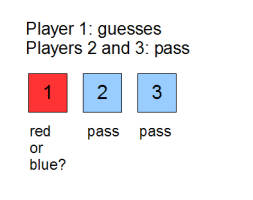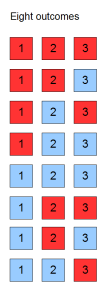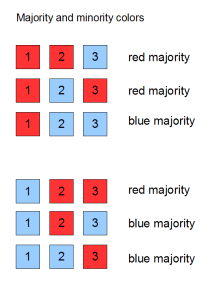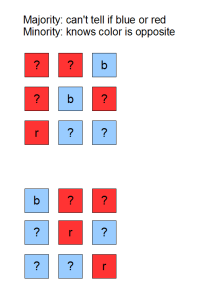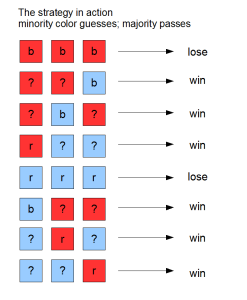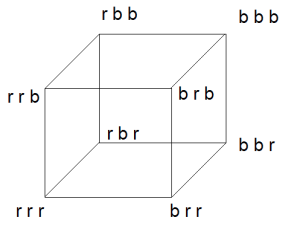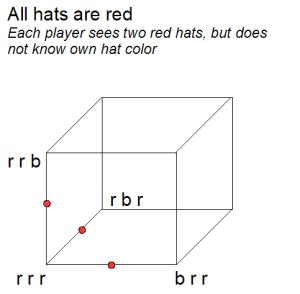5849
points
Questions
3400
Answers
237
-
If you knew the fake coin was lighter, then the solution would have an easy explanation. But you do not. So….
Number the coins 1 through 12.
1. Weigh coins 1,2,3,4 against coins 5,6,7,8.
1.1. If they balance, then weigh coins 9 and 10 against coins 11 and 8 (we know from the first weighing that 8 is a good coin).
1.1.1. If the second weighing also balances, we know coin 12 (the only one not yet weighed) is the counterfeit. The third weighing indicates whether it is heavy or light.
1.1.2. If (at the second weighing) coins 11 and 8 are heavier than coins 9 and 10, either 11 is heavy or 9 is light or 10 is light. Weigh 9 against 10. If they balance, 11 is heavy. If they don’t balance, you know that either 9 or 10 is light, so the top coin is the fake.
1.1.3 If (at the second weighing) coins 11 and 8 are lighter than coins 9 and 10, either 11 is light or 9 is heavy or 10 is heavy. Weigh 9 against 10. If they balance, 11 is light. If they don’t balance, you know that either 9 or 10 is heavy, so the bottom coin is the fake.
1.2. Now if (at first weighing) the side with coins 5,6,7,8 are heavier than the side with coins 1,2,3,4. This means that either 1,2,3,4 is light or 5,6,7,8 is heavy. Weigh 1,2, and 5 against 3,6, and 9.
1.2.1. If (when we weigh 1,2, and 5 against 3,6 and 9) they balance, it means that either 7 or 8 is heavy or 4 is light. By weighing 7 and 8 we obtain the answer, because if they balance, then 4 has to be light. If 7 and 8 do not balance, then the heavier coin is the counterfeit.
1.2.2. If (when we weigh 1,2, and 5 against 3,6 and 9) the right side is heavier, then either 6 is heavy or 1 is light or 2 is light. By weighing 1 against 2 the solution is obtained.
1.2.3. If (when we weigh 1,2, and 5 against 3, 6 and 9) the right side is lighter, then either 3 is light or 5 is heavy. By weighing 3 against a good coin the solution is easily arrived at.
1.3 If (at the first weighing) coins 1,2,3,4 are heavier than coins 5,6,7,8 then repeat the previous steps 1.2 through 1.2.3 but switch the numbers of coins 1,2,3,4 with 5,6,7,8.
- 8157 views
- 1 answers
- 0 votes
-
Q: What has a foot but no legs?
A: A snailQ: Poor people have it. Rich people need it. If you eat it you die. What is it?
A: NothingQ: What comes down but never goes up?
A: RainQ: I’m tall when I’m young and I’m short when I’m old. What am I?
A: A candleQ: Mary’s father has 5 daughters – Nana, Nene, Nini, Nono. What is the fifth daughters name?
A: If you answered Nunu, you are wrong. It’s Mary!Q: How can a pants pocket be empty and still have something in it?
A: It can have a hole in it.Q: In a one-story pink house, there was a pink person, a pink cat, a pink fish, a pink computer, a pink chair, a pink table, a pink telephone, a pink shower– everything was pink!
What color were the stairs?
A: There weren’t any stairs, it was a one story house!- 7341 views
- 1 answers
- 1 votes
-
Q: A dad and his son were riding their bikes and crashed. Two ambulances came and took them to different hospitals. The man’s son was in the operating room and the doctor said, “I can’t operate on you. You’re my son.”
How is that possible?
A: The doctor is his mom!Q: What goes up when rain comes down?
A: An umbrella!Q: What is the longest word in the dictionary?
A: Smiles, because there is a mile between each ‘s’Q: If I drink, I die. If i eat, I am fine. What am I?
A: A fire!Q: Throw away the outside and cook the inside, then eat the outside and throw away the inside. What is it?
A: Corn on the cob, because you throw away the husk, cook and eat the kernels, and throw away the cob.Q: What word becomes shorter when you add two letters to it?
A: ShortQ: What travels around the world but stays in one spot?
A: A stamp!Q: What occurs once in a minute, twice in a moment and never in one thousand years?
A: The letter MQ: What has 4 eyes but can’t see?
A: MississippiQ: If I have it, I don’t share it. If I share it, I don’t have it. What is it?
A: A Secret.- 8070 views
- 1 answers
- 1 votes
-
TO achieve 75 percent chance of winning
Strategy:
Player 1:
If see blue-red, then pick red.
If see red-blue, then pick blue.
Else pass.Player 2:
If see red-red, then pick blue.
If see blue-blue, then pick red.
Else pass.Player 3:
If see red-blue, then pick red.
If see blue-red, then pick blue
Else pass.Very good explanation at – EXPLANATION
EXPLAINATION From mindyourdecision.com –
(In the language of game theory, this is a simultaneous coordination game of incomplete information.)
If the players could talk after they had hats on, the game would be trivial. Since the players have incentive to cooperate, they would honestly reveal what they see. In a matter of seconds, they could all figure out their hat colors and guess correctly.
But the rules only allow for an initial strategy session. How well can the players fare? Amazingly, they can do pretty well.
The Basic Strategy (50 percent winning)
The rules heavily penalize incorrect guesses. A single incorrect guess makes the group lose–even if the other two players guess correctly. A single incorrect guess is the apple that spoils the bunch.
So it’s important the rules allow for players to pass. If a player doesn’t have a good guess, it would be a good idea to pass.
A basic strategy would be to minimize the risk of bad guesses. Force two players to pass in every game and make one person the official guesser. The group wins exactly when this person guesses correctly.
How often will the group succeed? Since the hat color is chosen by a coin flip, there is a 50 percent chance of guessing the correct color.
This is not too shabby when there’s a $3 million dollar reward at stake. I will take that gamble any day.
If I were conducting an interview, I would be satisfied if an applicant, never having heard the puzzle, came this far. The answer demonstrates basic risk management and an understanding of probability.
But can the team do better than random chance?
If you’ve been reading my game theory articles, then you would guess that they can. Players can do often do better than random chance if they consider the distribution of outcomes–a tactic I described in my article about finding true love.
The trick is figuring out the players do have a way of coordinating as a group. Doing this, they can make winning an amazing 75 percent chance. Let’s investigate why.
One Optimal Strategy (75 percent winning)
Motivating question: does observing the other two hat colors tell you anything about your own hat color? In other words, if you see two red hats, does that make your hat more likely to be blue?
The answer is no, and that’s a potential roadblock. Regardless of what you see, your hat color is determined by a coin flip. Fair coins are never “due” for a particular outcome–each toss is independent.
But don’t get caught up in probability–the fact is that seeing the other hat colors does convey information. The problem is the figuring out how to transmit that information to the other players.
To get around that, players need to coordinate guesses based on what they see. If possible, they still want to minimize bad guesses by having two people pass and one person guess. What’s needed now is a group strategy.
How can they do that? It starts by taking a step back and considering the possible distributions of hat outcomes. With three players and two hat colors, there are a total of eight equally likely outcomes:
Is there anything special about the distribution?
One feature is that most outcomes–six of them–include at least one hat of both colors. Only two extreme outcomes don’t–the ones with all red hats or all blue hats.
We can analyze further. Among outcomes with both hat colors, there logically has to be two hats of one color (the “majority” color) and one hat of another color (the “minority” color).
Here’s the kicker: by looking at the other hats, players can identify whether they are wearing a majority color or a minority color.
For instance, if a player sees both a red and blue hat, then the player must be wearing the majority color (which could be red or blue).
If a player sees two blue or two red hats, then the player must be wearing the minority color, which will be the opposite color of what the player sees.
Here is what players can reason among the six choices:
Now the idea is to get the player with the minority hat color to guess and force the other people to pass.
So here is the strategy:
- if you see both a red and a blue hat, then “pass”
- if you see two red hats, then guess “blue”
- if you see two blue hats, then guess “red”
This strategy wins in all six cases with at least one hat of each color. It only loses in the two cases of all-red or all-blue, in which all players guess incorrectly.
Here is how players would guess:
All told, the group wins in six of eight possible outcomes–a whopping 75 percent chance.
Optional Extra Credit: The Host can Learn
If you’re playing rock-paper-scissors against a computer that mixes randomly, you could win 1/3 of the time simply by picking one strategy, say rock. But if the computer could learn and analyze your pattern, it might respond by countering with paper and start winning a lot. To maintain your 1/3 winning chance, you need to randomize your choices among rock, paper, and scissors.
In the hat game, the players have a 75 percent chance of winning, but the strategy has a pattern. It loses every time the hat colors are all the same. A responsive host, like the computer in rock-paper-scissors, would see the pattern and respond by assigning hats to be the all one color more frequently. To keep the host honest, the players need to randomize.
Is there some a way the players can win, without creating a pattern of outcomes in which they all lose?
Amazingly, yes there is! Even more surprising, the winning percentage stays at 75 percent.
In researching this article, I learned about the claim and a proposed winning strategy from a presentation on Michel Waldschmit’s website called “Coding Theory, Card Tricks and Hat Problems.”
Unfortunately the slides didn’t contain the proof, or an example, so I felt a little bit like I was staring at the margin of a textbook from Fermat.
I took out my own pencil and paper and worked on the answer. I am happy to say I came up with the following analysis myself.
The Random Optimal Strategy (75 percent winning)
The random strategy is a refinement on the static one given above. The key to the above strategy is that players essentially bet against the outcome being all-red or all-blue. Knowing that, it was possible to coordinate guesses so only one person guessed and gave a correct answer.
There’s nothing special about picking all-red or all-blue.
The players can randomly pick any color combination and its “opposite” configuration (red-blue-red and blue-red-blue are opposites) as outcomes to bet against. The remaining six outcomes can be coded based on the hat colors that each player sees.
Why would this work, and why does it have to be “opposite” combinations?
The eight outcomes of the hat game can be visualized as vertices of a cube. Adjacent vertices differ by changing only a single “coordinate,” that is, the color of one player’s hat.
The graphical interpretation is as follows: can the players identify which vertex they belong to? The information they are given is the other two hat colors they see–that is, they are effectively placed at midway points along the adjacent edges.
Each player can see the coordinates of the other two players, but is unsure about the own coordinate–that is, the player is unsure which of the two possible endpoints the group belongs to.
We want a situation where exactly two players will not be able to tell the vertex (they will “pass”) and the remaining player will know the location (and guess correctly).
Such a unique coding occurs when players bet against a random vertex and the “opposite” one–a limitation that gives maximal location information.
In any of these cases, players only lose if in fact the outcome is one of the two they bet against, meaning they have a 75 percent chance of winning.
The 75 percent chance of winning applies to every time the game is played but the losing outcomes are randomized. Hence, the host won’t be able to exploit any particular color combination.
- 61006 views
- 5 answers
- -1 votes
-
The answer is Ages 1, 1 and 36!
Clue 1 makes sure that all the possible ages must have a product of 36. Many threads below have the right idea.
Clue 2 ensures that next door (always either+2 or -2) from your own number. Therefore the sum of the ages must be either +2 or -2 from the product. The only combination possible is 1, 1 & 36 with a product of 36 and a sum of 38.
Clue 3 cannot see the need for it! (But at 36 you could still be learning the piano!)
Youngest
Middle
Eldest
Product
Sum
Diff
1
1
36
36
38
2
1
2
18
36
21
-15
1
3
12
36
16
-20
1
4
9
36
14
-22
1
6
6
36
13
-23
2
2
9
36
13
-23
2
3
6
36
11
-25
2
3
6
36
11
-25
- 10330 views
- 2 answers
- 0 votes
-
Just take top 15 cards from the pile and reverse them,
now you will have two piles of 15 cards and 37 cards and both of them will have same number of inverted cards.
Inverted Playing card puzzle explanation:Lets say there were n inverted cards initially in top 15 cards,
obviously
In remaining 37 cards number of inverted cards will be 15-n, as total 15 inverted cards.Now on reversing the 15 cards number of inverted cards would become 15 – n and number of inverted cards will become same in the two piles.
- 40414 views
- 5 answers
- 2 votes
-
Etymologized
Meaning – give or trace the etymology of (a word).
Etym – shout at the top of your voice!
ogiz – Trade
ezym – Tail
izlo – an animal
olog – calfs cry
- 4582 views
- 1 answers
- 0 votes
-
TREASURE
5,6,7,8 – sure
4,5,5,6,7,8- assure
2,3,4,5,5,6,7,8 – reassure- 4319 views
- 1 answers
- 0 votes
-
MONODRAMA
1,2,3 – MON(a city in BURMA)
5,6,7 -DRA (an ancient star ‘the dragon’
6,7,8,9 – RAMA (Lord Rama)
Mon is actually a city conquered by the BURMANS.
It lies in the Eastern delta region of Myanmar- 3448 views
- 1 answers
- 0 votes
-
Exchange camels
- 11369 views
- 2 answers
- 1 votes


